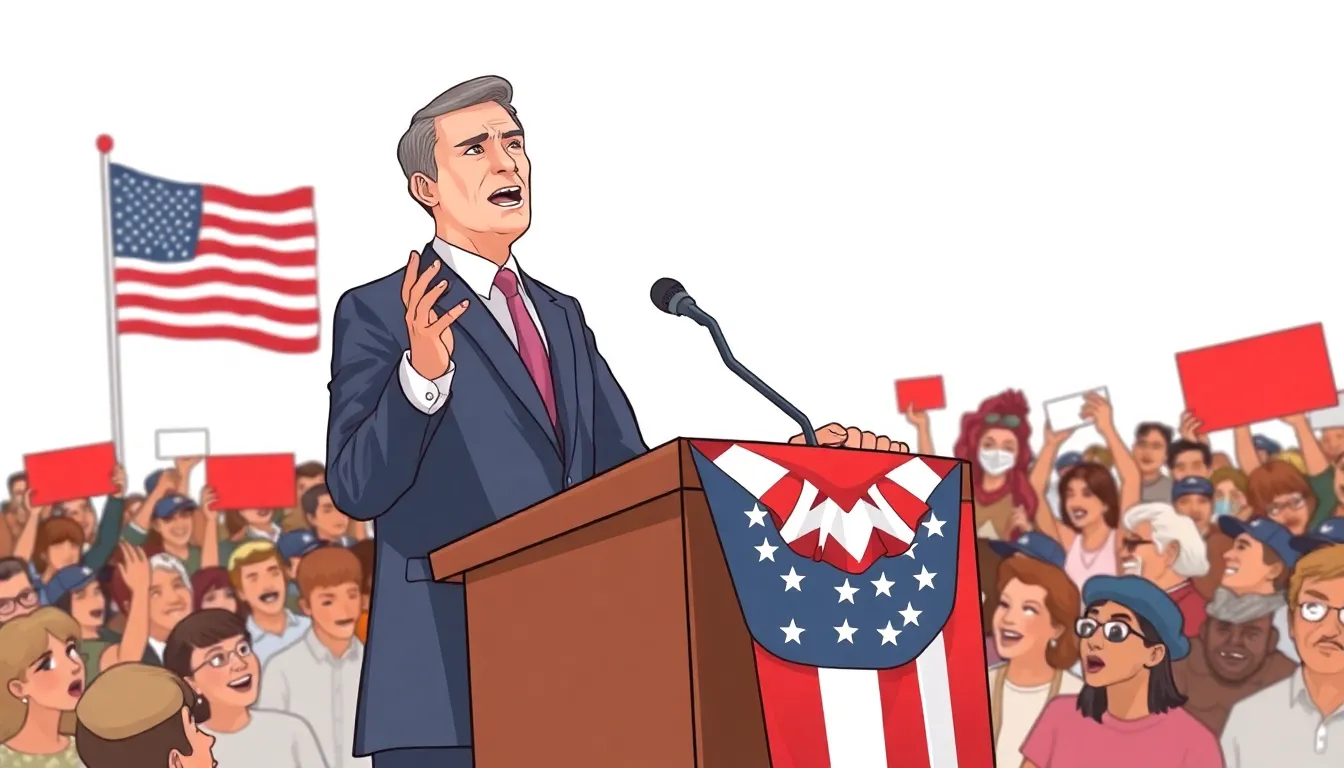Political speeches can be a wild ride, blending inspiration with a sprinkle of drama. They’re the moments when leaders take center stage, armed with words that can ignite a movement or send audiences into a collective eye-roll. From soaring rhetoric to awkward pauses, these speeches shape opinions, rally support, and sometimes even leave listeners scratching their heads in confusion.
Imagine a world where politicians master the art of persuasion without the cringe factor. With the right blend of humor and passion, a political speech can not only engage but also entertain. It’s not just about what’s said; it’s about how it’s delivered. Whether they’re addressing a crowd of thousands or a handful of supporters, the best speeches resonate, inspire, and occasionally make us chuckle at the absurdity of it all. Dive into the world of political speeches and discover what makes them unforgettable.
Table of Contents
ToggleOverview of Political Speeches
Political speeches serve as powerful tools for communication, persuasion, and inspiration. They often reflect the speaker’s values and beliefs while also addressing the concerns of the audience. Key elements contribute to the success of these speeches.
Content often includes specific policy proposals, personal stories, and emotional appeals. Such elements help create a relatable connection with listeners. Structure plays a vital role in the delivery. Engaging political speeches typically follow a clear format, including an introduction, body, and conclusion, allowing audiences to easily follow the message.
Rhetorical devices enhance the impact of speeches, making them memorable. Techniques like repetition, metaphors, and anecdotes capture attention and evoke emotion. Historical references frequently solidify arguments and credibility. These references resonate with listeners, providing context and relatability.
Audience analysis proves essential for tailoring messages to specific groups. Understanding demographic factors like age, interests, and cultural backgrounds allows speakers to connect more effectively. Adaptation to various settings is crucial, from large rallies to intimate gatherings, ensuring the speech remains relevant.
Delivery style influences audience perception. Factors such as tone, pace, and body language play significant roles. Poised speakers captivate and retain attention, enhancing message retention. Therefore, practice and preparation become vital for those aiming to deliver impactful speeches.
Political speeches encompass various elements, including content, structure, rhetorical devices, audience analysis, and delivery style. Mastering these components leads to effective communication, inspiring listeners and influencing public opinion.
Historical Context

Political speeches have deep roots in human communication, serving as a key means of persuasion and advocacy. Understanding the historical context enriches the appreciation of their development and significance.
Early Political Speeches
Early political speeches can be traced back to ancient civilizations. Figures like Cicero in Rome and Pericles in Athens used oratory to influence public opinion and civic engagement. These speeches often addressed substantial issues such as governance, justice, and societal values. Rhetoric was not just a tool for persuasion; it was an art form that shaped political landscapes. The use of audience engagement techniques, personal anecdotes, and moral appeals characterized these foundational speeches, leaving a lasting impact on the practice of political oratory.
Evolution Through Time
Political speeches evolved significantly through various historical eras. The Renaissance brought a renewed emphasis on individual expression and human rights, impacting political discourse. In the 18th and 19th centuries, leaders like Abraham Lincoln and Frederick Douglass harnessed the power of speech to address grievances like slavery and civil rights. Advancements in communication technology further transformed speech delivery. Radio and television emerged, allowing speeches to reach broader audiences. Today, social media platforms enable politicians to engage directly with constituents, illustrating a continuous evolution in how political messages are crafted and delivered. The narrative of political speeches is shaped by the changing needs of society.
Key Elements of Effective Political Speeches
Effective political speeches incorporate several key elements that enhance their impact. Understanding rhetoric and persuasion is vital for crafting a compelling message.
Rhetoric and Persuasion
Rhetoric serves as the backbone of political speechwriting. Speakers employ persuasive strategies to influence opinions and inspire action. By utilizing rhetorical devices like anaphora, which repeats phrases for emphasis, speakers can leave a lasting impact. Metaphors help simplify complex ideas, allowing audiences to grasp nuanced subjects easily. Additionally, anecdotes provide relatable stories that humanize leaders, creating emotional connections. A focused message, coupled with strategic choices in language, elevates the overall effectiveness of the speech. Clear articulation of policy proposals directs attention toward actionable change and engages voters in critical discussions.
Audience Engagement
Engaging the audience proves essential for successful political speeches. Analyzing demographic factors like age and cultural background allows for tailoring messages. Incorporating humor can capture attention and lighten serious topics, fostering a connection with listeners. Asking rhetorical questions encourages the audience to think critically and personally relate to the material. Eye contact and body language enhance the connection, demonstrating authenticity and confidence. Inviting audience participation or feedback encourages a sense of inclusion, making listeners feel valued and involved. Thus, effective audience engagement not only strengthens the speech’s impact but also fosters a lasting connection between the speaker and the listeners.
Notable Political Speeches in History
Political speeches have played a crucial role in shaping public opinion and influencing national policies. Speeches often reflect pivotal moments in history, showcasing the power of rhetoric.
Speeches That Shaped Nations
Abraham Lincoln’s Gettysburg Address remains a cornerstone of American political discourse. Delivered in 1863, this brief yet impactful speech emphasized unity and the principles of human equality. Martin Luther King Jr.’s “I Have a Dream” speech from 1963 galvanized the civil rights movement by articulating a vision of racial harmony and justice. Winston Churchill’s wartime speeches rallied the British during World War II, instilling a spirit of resilience in the face of adversity. Each of these speeches not only inspired their immediate audiences but also left lasting legacies, shaping the collective identity of their nations.
Contemporary Influences
In modern politics, Barack Obama’s 2008 victory speech highlighted hope and change, resonating with diverse demographics. Donald Trump’s speeches often utilized bold language, appealing to populist sentiments and energizing his base. Greta Thunberg’s speeches on climate change have mobilized global youth activism, emphasizing urgency in addressing environmental issues. Each of these contemporary speeches reflects shifting public values and concerns, demonstrating how political messaging continues to evolve in response to current challenges.
Analysis of Political Speech Techniques
Political speeches utilize various techniques to captivate and persuade audiences. Rhetorical devices such as repetition and metaphor simplify complex topics, reinforcing key messages. Personal anecdotes often make speeches relatable, fostering emotional connections with listeners.
Audience analysis emerges as essential for tailoring messages. Factors such as age, cultural background, and values shape how political content resonates. Engaging the audience through humor or questions enhances participation, creating a dialogue rather than a monologue.
Structure remains critical in effective speeches. Typically, a clear introduction, body, and conclusion ensure the message flows logically. Speeches also incorporate pauses and varied pacing to emphasize important points, maintaining audience engagement.
Delivery techniques play a significant role in perception. Tone and body language directly influence how messages are received. Practice facilitates smoother delivery, allowing speakers to project confidence and command attention.
Historical references contribute to a speech’s credibility. Citing past events or figures can ground arguments in reality, providing context that resonates with audiences. Moreover, the legacy of impactful speeches further illustrates the power of rhetoric to shape public opinion.
Recent developments in technology have transformed political speech delivery. Platforms like social media allow for increased interaction, making political messaging more immediate and accessible. These innovations reflect society’s evolving values and expectations.
Each of these techniques combines to create powerful speeches that inspire and influence listeners, shaping political landscapes across generations.
Political speeches remain a vital aspect of communication in the political arena. They have the power to motivate and mobilize audiences while addressing pressing societal issues. By understanding the intricate components that make these speeches effective, speakers can craft messages that resonate deeply with listeners.
As the landscape of communication continues to evolve, the art of political oratory adapts to meet the needs of modern audiences. Whether through historical references or contemporary examples, the impact of well-delivered speeches can shape public opinion and inspire action. Mastering the techniques of rhetoric and delivery is essential for anyone looking to make a meaningful impact in the political sphere.



